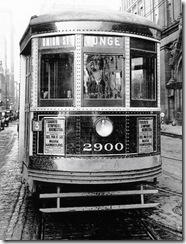The following quote is from the recently published murder/mystery “The Reluctant Virgin.”
Jokes and stories that involved the Peter Witt streetcars on Toronto’s Yonge Street invariably began with, “A passenger was on the Yonge streetcar and…” In later years, Tom remembered how much he had enjoyed the corny Yonge-streetcar jokes, even though many of them were childish humour.
Tom never forgot his dad’s story about a plump, elegantly attired elderly woman. While travelling on a crowded Yonge streetcar, she noisily broke wind. The young man seated next to her, amused by the loudness of the blast, accidentally dropped the streetcar transfer clutched in his hand. The woman, self-conscience at her indiscretion, bent over and discretely retrieved the transfer from the floor of the streetcar, and passed it to the man.
When she handed it to him, the young man looked at the paper transfer and said, “I think you had best keep it. You may need it to wipe yourself, and when we go past the next tree I’ll reach out the window and get you a few leaves.”
The woman was not amused, and relocated to another seat further down the streetcar. When she got off at St. Clair, she glowered at the insolent young fellow. He graciously smiled at her and tipped his hat.
Tom’s dad loved telling the story, even though his mom objected to its crudeness.
The story that Tom recalled the best was one that created a little drama in the Hudson house. He could still picture the look of mischief on Gramps’ face as he commenced the tale, making no effort to sanitize his language.
“I heard today about a passenger on the Yonge Streetcar,” he began. “She was returning from the St. Lawrence Market with her weekly supply of fruits and vegetables in paper bags. As the streetcar approached Queen Street, the bottom of one of the paper bags broke open, and a half-dozen oranges dropped out and rolled across the floor of the streetcar. She deposited her other bag on the floor of the streetcar, and bent over to pick up the oranges, which by now were rolling around on the floor of the car. While bending over, she ripped off a loud fart.”
Gramps was laughing as he talked. Nan’s face portrayed her disgust with his street language, and Tom’s mom was clearly not amused.
Ignoring their disapproval, Gramps continued.
“When the woman ripped off the loud fart, an old man who was standing near her said, “That’s right, lady, if you can’t catch them—shoot them.’”
Gramps, Ken, and Tom laughed uproariously. Nan left the room and went out to sit in the sun porch. Tom’s mom, who continued to peel the vegetables for supper said, “When a grown man tells a boy’s joke, it does him no credit.”
“Perhaps not,” Tom’s dad replied. “But I thought it was quite funny.”
“You men always stick together, even when you’re in the wrong,” Tom’s mom declared.
After a few minutes, Gramps wandered out to the sun porch where Nan was now sitting. Feeling the need to placate her he said, “You must at least give me credit for one thing. When I first met you, dear, I thought that if I couldn’t catch you, instead of shooting oranges, I’d shoot myself. The only reason I’m alive today is because you agreed to marry me.”
“So instead of shooting yourself then, you’re shooting the bull now,” she replied.
For Tom, remembering Gramp’s story always brought back fond memories of his teenage years on Lauder Avenue. Similarly, Toronto’s Yonge Streetcars recalled pleasant times of a decade and a city that has slipped into the mists of time.
To view the Home Page for this blog: https://tayloronhistory.com/
To view previous posts about movie houses of Toronto—old and new
https://tayloronhistory.com/2013/10/09/links-to-toronto-old-movie-housestayloronhistory-com/
To view links to other posts placed on this blog about the history of Toronto and its heritage buildings:
https://tayloronhistory.com/2013/10/08/links-to-historic-architecture-of-torontotayloronhistory-com/
Recent publication entitled “Toronto’s Theatres and the Golden Age of the Silver Screen,” by the author of this blog. The publication explores 50 of Toronto’s old theatres and contains over 80 archival photographs of the facades, marquees and interiors of the theatres. It also relates anecdotes and stories from those who experienced these grand old movie houses.
To place an order for this book:
Theatres Included in the Book
Chapter One – The Early Years—Nickelodeons and the First Theatres in Toronto
Theatorium (Red Mill) Theatre—Toronto’s First Movie Experience and First Permanent Movie Theatre, Auditorium (Avenue, PIckford), Colonial Theatre (the Bay), thePhotodome, Revue Theatre, Picture Palace (Royal George), Big Nickel (National, Rio), Madison Theatre (Midtown, Capri, Eden, Bloor Cinema, Bloor Street Hot Docs), Theatre Without a Name (Pastime, Prince Edward, Fox)
Chapter Two – The Great Movie Palaces – The End of the Nickelodeons
Loew’s Yonge Street (Elgin/Winter Garden), Shea’s Hippodrome, The Allen (Tivoli), Pantages (Imperial, Imperial Six, Ed Mirvish), Loew’s Uptown
Chapter Three – Smaller Theatres in the pre-1920s and 1920s
Oakwood, Broadway, Carlton on Parliament Street, Victory on Yonge Street (Embassy, Astor, Showcase, Federal, New Yorker, Panasonic), Allan’s Danforth (Century, Titania, Music Hall), Parkdale, Alhambra (Baronet, Eve), St. Clair, Standard (Strand, Victory, Golden Harvest), Palace, Bedford (Park), Hudson (Mount Pleasant), Belsize (Crest, Regent), Runnymede
Chapter Four – Theatres During the 1930s, the Great Depression
Grant ,Hollywood, Oriole (Cinema, International Cinema), Eglinton, Casino, Radio City, Paramount, Scarboro, Paradise (Eve’s Paradise), State (Bloordale), Colony, Bellevue (Lux, Elektra, Lido), Kingsway, Pylon (Royal, Golden Princess), Metro
Chapter Five – Theatres in the 1940s – The Second World War and the Post-War Years
University, Odeon Fairlawn, Vaughan, Odeon Danforth, Glendale, Odeon Hyland, Nortown, Willow, Downtown, Odeon Carlton, Donlands, Biltmore, Odeon Humber, Town Cinema
Chapter Six – The 1950s Theatres
Savoy (Coronet), Westwood
Chapter Seven – Cineplex and Multi-screen Complexes
Cineplex Eaton Centre, Cineplex Odeon Varsity, Scotiabank Cineplex, Dundas Square Cineplex, The Bell Lightbox (TIFF)


![cid_E474E4F9-11FC-42C9-AAAD-1B66D852[2] cid_E474E4F9-11FC-42C9-AAAD-1B66D852[2]](https://tayloronhistory.com/wp-content/uploads/2014/10/cid_e474e4f9-11fc-42c9-aaad-1b66d8522_thumb4.jpg)